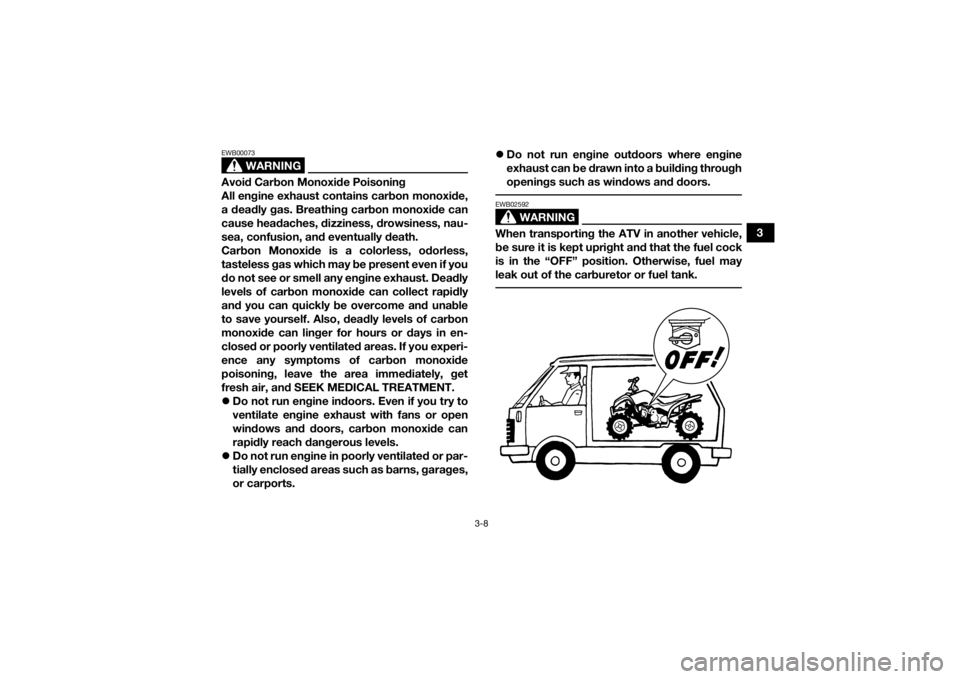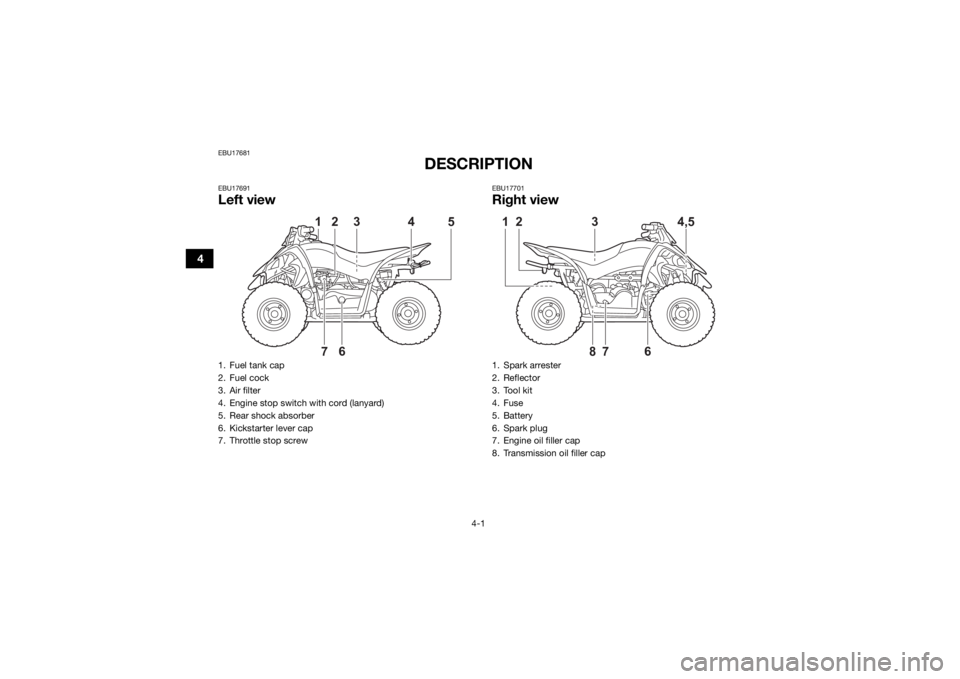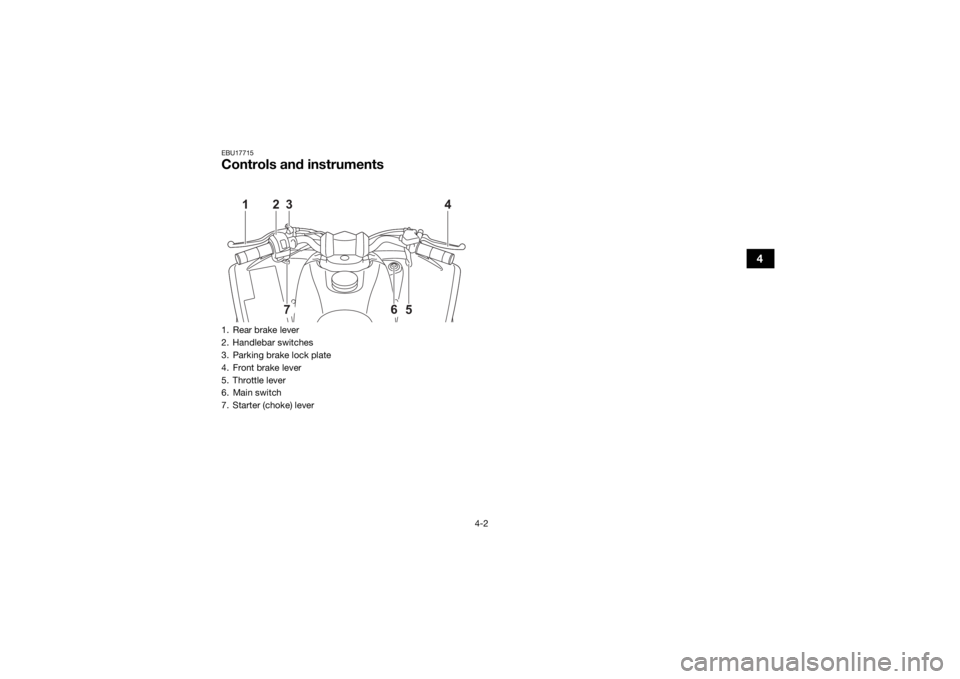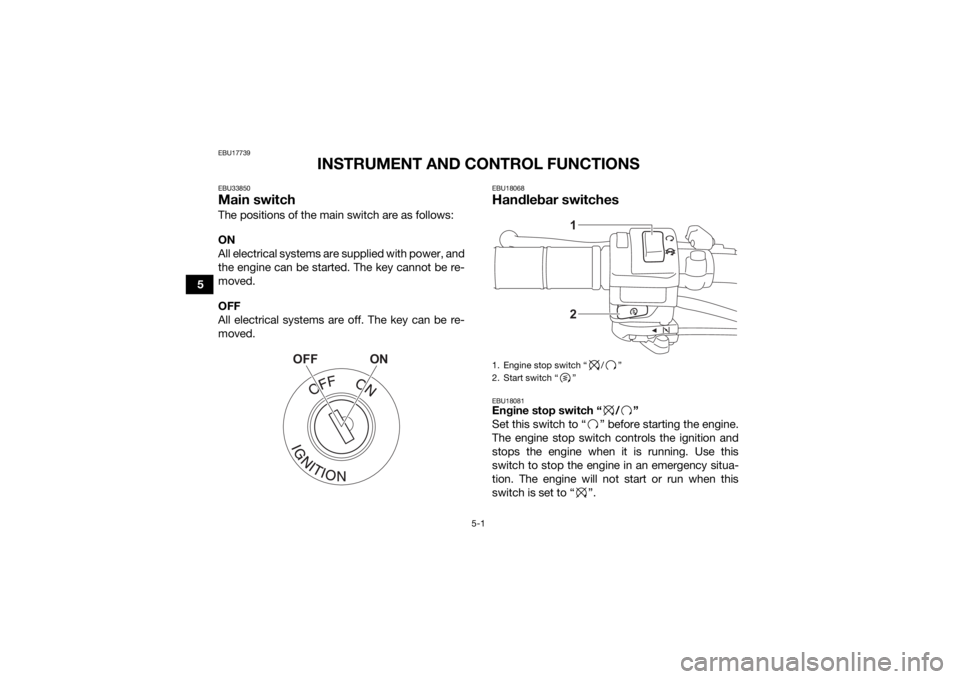YAMAHA YFZ50 2021 Owner's Manual
Manufacturer: YAMAHA, Model Year: 2021, Model line: YFZ50, Model: YAMAHA YFZ50 2021Pages: 126, PDF Size: 4.89 MB
Page 21 of 126

3-2
3
Never consume alcohol or drugs before or while
operating this ATV.
Never operate at speeds too fast for your skills
or the riding conditions. Always go at a speed
that is proper for the terrain, visibility, operating
conditions, and your experience.
Never attempt wheelies, jumps, or other stunts.
Always inspect your ATV each time you use it to
make sure it is in safe operating condition. Al-
ways follow the inspection and maintenance
procedures and schedules described in this
manual.
Always keep both hands on the handlebars and
both feet on the footrests of the ATV during op-
eration.
Always go slowly and be extra careful when op-
erating on unfamiliar terrain. Always be alert to
changing terrain conditions when operating the
ATV.
Never operate on excessively rough, slippery or
loose terrain until you have learned and prac-
ticed the skills necessary to control the ATV on
such terrain. Always be especially cautious on
these kinds of terrain.
Always follow proper procedures for turning as
described in this manual. Practice turning at low
speeds before attempting to turn at faster
speeds and never turn at excessive speeds.
Never operate the ATV on hills too steep for the
ATV or for your abilities. Practice on smaller hills
before attempting larger hills.
Always follow proper procedures for climbing
hills as described in this manual. Check the ter-
rain carefully before you start up any hill. Never
climb hills with excessively slippery or loose
surfaces. Shift your weight forward. Never open
the throttle suddenly or make sudden gear
changes. Never go over the top of a hill at high
speed.
Always follow proper procedures for going
down hills and for braking on hills as described
in this manual. Check the terrain carefully before
you start down any hill. Shift your weight back-
ward. Never go down a hill at high speed. Avoid
going down a hill at an angle that would cause
the vehicle to lean sharply to one side. Go
straight down the hill where possible.
Always follow proper procedures for crossing
the side of a hill as described in this manual.
Avoid hills with excessively slippery or loose
UBW464E0.book Page 2 Thursday, January 23, 2020 2:42 PM
Page 22 of 126

3-3
3surfaces. Shift your weight to the uphill side of
the ATV. Never attempt to turn the ATV around
on any hill until you have mastered the turning
technique described in this manual on level
ground. Avoid crossing the side of a steep hill if
possible.
Always use proper procedures if you stall or roll
backwards when climbing a hill. If you stall or
roll backwards, follow the special procedure for
braking described in this manual. Dismount on
the uphill side or to a side if pointed straight up-
hill. Turn the ATV around and remount, following
the procedure described in this manual.
Always check for obstacles before operating in
a new area.
Never attempt to operate over large obstacles,
such as large rocks or fallen trees. Always follow
proper procedures when operating over obsta-
cles as described in this manual.
Always be careful when skidding or sliding.
Learn to safely control skidding or sliding by
practicing at low speeds and on level, smooth
terrain. On extremely slippery surfaces, such as
ice, go slowly and be very cautious in order to
reduce the chance of skidding or sliding out of
control.
Never operate an ATV in fast flowing water or in
water deeper than that recommended in this
manual. Remember that wet brakes may have
reduced stopping ability. Test your brakes after
leaving water. If necessary, apply them several
times to let friction dry out the linings.
Always use the size and type of tires specified in
this manual.
Always maintain proper tire pressure as de-
scribed in this manual.
Never exceed the stated load capacity for an
ATV. Cargo should be properly distributed and
securely attached. Reduce speed and follow in-
structions in this manual for carrying cargo or
pulling a trailer. Allow greater distance for brak-
ing.
Do not operate your ATV during darkness un-
less it is equipped with a properly functioning
headlight. Off-road riding is inherently danger-
ous and additionally, off-road trails do not have
streetlights to guide you.
Never maintain an ATV without proper knowl-
edge. Contact an authorized ATV dealer to in-
form you on basic ATV maintenance. Certain
maintenance can only be carried out by certified
staff.
UBW464E0.book Page 3 Thursday, January 23, 2020 2:42 PM
Page 23 of 126

3-4
3
In the event of an accident
1. If serious injuries are incurred, you may be safer staying next to your vehicle; it may
shield you from oncoming riders. Depending
on your injuries and position in the trail; you
must make a judgment call as to whether you
should move to a position off the trail. If you
have sustained head, neck, or back injuries,
or cannot feel your limbs, you should not
move. Keep your helmet on and remain mo-
tionless. Lie down next to your vehicle and
wait for help.
2. If less serious injuries are incurred and you can walk, then move to a position off the trail.
Check yourself for injuries and apply first aid
as needed.
3. If your injuries are light, when safe to do so, move your vehicle off the trail to avoid colli-
sions with oncoming riders. Check for injuries
and apply first aid as necessary. If you can
physically operate your vehicle, inspect your
vehicle. If the vehicle is in safe operating con-
dition and you can safely operate it, restart it
and ride gently back to camp or other known
location where you can receive medical at- tention. If necessary, contact your riding party
or local authorities to let them know where
you are and what has happened.
In the event of a breakdown 1. If your vehicle will not restart or is not in safe operating condition, turn off the main switch
and engine stop switch. If the breakdown oc-
curs at twilight or night, leave the main switch
on so that your lights may warn other riders of
your stopped vehicle.
2. Get out of danger. Check for oncoming vehi- cles and when safe, push your vehicle to the
side of the trail or even off the main trail to
avoid any possible collisions with oncoming
riders. If you cannot move your vehicle by
yourself, when safe, walk to the nearest van-
tage point and signal an oncoming rider to
help you push your vehicle to a safe place off
the trail.
3. Inspect your vehicle for any immediate haz- ardous conditions. The most obvious hazard-
ous conditions are leaking fuel and
ungrounded or broken wiring. Visually check
for broken wiring and leaking fuel. Leaking
fuel can be confirmed by the odor of gasoline.
UBW464E0.book Page 4 Thursday, January 23, 2020 2:42 PM
Page 24 of 126

3-5
34. Once immediate safety hazards are con-
firmed not to exist, you may remove your hel-
met to more closely inspect your vehicle.
Check for external signs of wear, broken
parts, fluid leaks, cracks in the frame, sus-
pension damage, wheel damage, and so on.
Fuel, oil, and coolant usually give off a notice-
able odor.
5. If your vehicle will not restart or if it is unsafe to ride, then turn off all vehicle systems (en-
gine stop switch, main switch, and fuel cock),
and then signal or go for help.
Aftermarket Parts, Accessories, and Modifica-
tions
While you may find aftermarket products similar in
design and quality to genuine Yamaha accesso-
ries, recognize that some aftermarket accessories
or modifications are not suitable because of po-
tential safety hazards to you or others. Installing
aftermarket products or having other modifica-
tions performed to your vehicle that change any of
the vehicle’s design or operation characteristics
can put you and others at greater risk of serious
injury or death. You are responsible for injuries re-
lated to changes in the vehicle. Keep the following guidelines in mind, as well as those found in the
Loading section (page 7-6) when mounting acces-
sories.
Never install accessories that would impair the
performance of your ATV. Carefully inspect the
accessory before using it to make sure that it
does not in any way reduce ground clearance,
limit suspension travel, steering travel or control
operation.
Accessories fitted to the ATV can create insta-
bility due to improper weight distribution.
Bulky or large accessories may seriously affect
the stability of the ATV.
Certain accessories can displace the operator
from his or her normal riding position. This im-
proper position limits the freedom of movement
of the operator and may limit control ability,
therefore, such accessories are not recom-
mended.
Use caution when adding electrical accesso-
ries. If electrical accessories exceed the capac-
ity of the ATV’s electrical system, an electric
failure could result, which could cause a dan-
gerous loss of lights or engine power. Also, the
battery tends to discharge more quickly if elec-
trical accessories are added.
UBW464E0.book Page 5 Thursday, January 23, 2020 2:42 PM
Page 25 of 126

3-6
3
TEACHING YOUR CHILD TO OPERATE THE
ATV
WARNING
EWB00081Never let your child ride an ATV without close
adult supervision (a child under 6 should not
ride this ATV even with adult supervision).
Promptly correct your child if he or she begins
to ride beyond his or her abilities and, if neces-
sary, intervene by pulling the cord (lanyard) to
stop the engine.
If the child rides beyond his or her abilities, or
rides in terrain that is too difficult, he or she
may lose control of the ATV, causing an acci-
dent.
Introduce new riding areas slowly and make
sure the riding area matches your child’s skill
level. You must make the commitment to your child’s
proper use of the ATV. Your child must rely upon
you to be sure he or she has the development,
proper training, and proper equipment, as well as
an appropriately sized ATV and an appropriate rid-
ing area. Be sure your child is ready to learn how to ride
As a parent, your first step is to decide when your
child has the strength, skills, and judgment to
learn how to operate an ATV safely. Re-evaluate
your child’s readiness before every use; a child
who is too tired or distracted should not be al-
lowed to operate the ATV.
Be sure your child is properly trained
Your child should take a certified training course.
Training will continue with you as the instructor, so
you should be sure you thoroughly understand
proper riding techniques before continuing to in-
struct your child. Go through this Owner’s Manual
page by page with your child and be sure he or
she understands how to operate the ATV properly.
Be sure your child is wearing all the proper
safety equipment
Your child must always wear an approved motor-
cycle helmet that fits properly. Your child should
also wear the safety equipment described in the
Riding Your ATV section of this manual.UBW464E0.book Page 6 Thursday, January 23, 2020 2:42 PM
Page 26 of 126

3-7
3Choose an appropriate riding area
Select an area appropriate for your child to learn
to ride. (See page 8-9.) Follow the instructions in
the Riding Your ATV section of this manual.
Choose a large, flat, unpaved road or area that is
free of obstacles and away from other vehicles.
Supervise every use of the ATV
Because an adult must supervise every ATV oper-
ator under age 16, you should closely watch your
child every time he or she uses the ATV. Be ready
to intervene immediately if the child is not operat-
ing according to your guidelines. This ATV is fitted
with an engine stop switch cord (lanyard) device
that will let you stop the engine remotely as you
walk behind the vehicle.
ENGINE STOP SWITCH CORD
This model has an engine stop switch cord (lan-
yard) designed for use by an adult supervising the
child operating the ATV. When using the engine
stop switch cord, be sure the speed limiter on the
handlebar is adjusted and the engine speed limiter
plate is installed to limit the ATV to a walking
speed. (See page 5-3.) 1. Install the cap on the end of the engine stop
switch cord onto the engine shut-off switch
(white button).
2. Put your fingers in the loop at the other end of the cord.
3. As your child is riding, walk behind the ATV, closely watching his or her actions as well as
the path ahead.
4. If there is a potential hazard ahead or if your child is not riding correctly, pull firmly on the
cord (lanyard) to stop the engine. Because
the ATV will continue to roll for some dis-
tance, allow extra time and distance to pull
the cord before a potentially hazardous situa-
tion might be encountered.
When your child has developed sufficient skill to
no longer need you to follow with the cord, se-
curely tie up the cord. However, you must still
closely supervise your child at all times during ATV
operation.
TIPThe ATV will not start without the cap in place. Be
sure to remove the cord and store it in a safe place
to prevent operation of the ATV when you are not
around to supervise.
UBW464E0.book Page 7 Thursday, January 23, 2020 2:42 PM
Page 27 of 126

3-8
3
WARNING
EWB00073Avoid Carbon Monoxide Poisoning
All engine exhaust contains carbon monoxide,
a deadly gas. Breathing carbon monoxide can
cause headaches, dizziness, drowsiness, nau-
sea, confusion, and eventually death.
Carbon Monoxide is a colorless, odorless,
tasteless gas which may be present even if you
do not see or smell any engine exhaust. Deadly
levels of carbon monoxide can collect rapidly
and you can quickly be overcome and unable
to save yourself. Also, deadly levels of carbon
monoxide can linger for hours or days in en-
closed or poorly ventilated areas. If you experi-
ence any symptoms of carbon monoxide
poisoning, leave the area immediately, get
fresh air, and SEEK MEDICAL TREATMENT.
Do not run engine indoors. Even if you try to
ventilate engine exhaust with fans or open
windows and doors, carbon monoxide can
rapidly reach dangerous levels.
Do not run engine in poorly ventilated or par-
tially enclosed areas such as barns, garages,
or carports.
Do not run engine outdoors where engine
exhaust can be drawn into a building through
openings such as windows and doors.
WARNING
EWB02592When transporting the ATV in another vehicle,
be sure it is kept upright and that the fuel cock
is in the “OFF” position. Otherwise, fuel may
leak out of the carburetor or fuel tank.
UBW464E0.book Page 8 Thursday, January 23, 2020 2:42 PM
Page 28 of 126

4-1
4
EBU17681
DESCRIPTION
EBU17691Left view
EBU17701Right view
1. Fuel tank cap
2. Fuel cock
3. Air filter
4. Engine stop switch with cord (lanyard)
5. Rear shock absorber
6. Kickstarter lever cap
7. Throttle stop screw
12
4
5
3
6
7
1. Spark arrester
2. Reflector
3. Tool kit
4. Fuse
5. Battery
6. Spark plug
7. Engine oil filler cap
8. Transmission oil filler cap1
23
4,5
6
78
UBW464E0.book Page 1 Thursday, January 23, 2020 2:42 PM
Page 29 of 126

4-2
4
EBU17715Controls and instruments1. Rear brake lever
2. Handlebar switches
3. Parking brake lock plate
4. Front brake lever
5. Throttle lever
6. Main switch
7. Starter (choke) lever
12376 54
UBW464E0.book Page 2 Thursday, January 23, 2020 2:42 PM
Page 30 of 126

5-1
5
EBU17739
INSTRUMENT AND CONTROL FUNCTIONS
EBU33850Main switchThe positions of the main switch are as follows:
ON
All electrical systems are supplied with power, and
the engine can be started. The key cannot be re-
moved.
OFF
All electrical systems are off. The key can be re-
moved.
EBU18068Handlebar switchesEBU18081Engine stop switch “ / ”
Set this switch to “ ” before starting the engine.
The engine stop switch controls the ignition and
stops the engine when it is running. Use this
switch to stop the engine in an emergency situa-
tion. The engine will not start or run when this
switch is set to “ ”.
ON
OFF
1. Engine stop switch ´ L